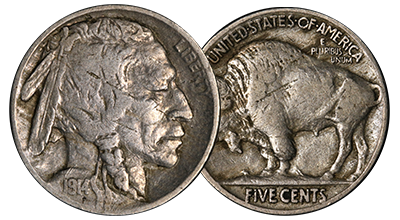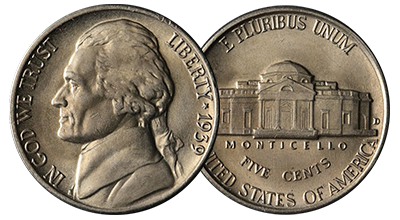US Nickel For Sale
Throughout history, the USA has minted many different nickels. These coins are very popular with collectors today and are often valuable. Examples of nickels include the shield nickel and the liberty head nickel, which are two of the most famous and popular American coins. Buffalo nickels are also rare and worth collecting. Continue reading to learn more about us nickel coins.
The journey of the U.S. nickel coin began in 1866 with the introduction of the Shield nickel, marking a departure from the silver half dimes used previously. Over the years, the nickel has seen several design changes, each reflecting a unique period in American history. From the Liberty Head V nickel to the Buffalo (Indian Head) nickel, and the long-standing Jefferson nickel, each design iteration tells a story of artistic evolution and national identity.
Designs and Variations
- Shield Nickel (1866-1883): The first of its kind, featuring a shield on the obverse and a numeral 5 surrounded by stars and rays on the reverse.
- Liberty Head V Nickel (1883-1913): Known for its portrayal of Lady Liberty and the large Roman numeral V on the reverse.
- Buffalo Nickel (1913-1938): Celebrated for its distinctly American imagery with a Native American on the obverse and a buffalo on the reverse.
- Jefferson Nickel (1938-present): Featuring a portrait of Thomas Jefferson on the obverse and his Monticello home on the reverse, with various commemorative designs introduced in the 21st century.
US Nickel Value
Nickels hold a special place in the hearts of collectors, from casual hobbyists to serious numismatists. The value of a nickel coin can vary dramatically based on its condition, rarity, historical significance, and any mint errors. Notable rarities include the 1913 Liberty Head nickel, one of the most coveted coins in U.S. numismatics, and the 1937-D "Three-Legged" Buffalo nickel, a testament to the fascinating errors that can occur in the minting process.
Buy Rare Nickels Online
Rare US nickels are highly sought after by collectors due to their scarcity, historical significance, and unique stories. Here's a list of some of the most notable rare nickels, which stand out in the world of numismatics:
1. 1913 Liberty Head Nickel
- Why It's Rare: Only five known examples exist. These nickels were never officially released by the U.S. Mint, making their existence a mystery and highly coveted among collectors.
- Notable Sale: One sold for over $3.7 million at auction in 2010.
2. 1921-S Buffalo Nickel
- Why It's Rare: The lowest mintage of any Buffalo nickel, with just over 1.5 million coins produced. Its scarcity, especially in higher grades, makes it a prized possession.
- Notable Sale: High-grade examples can fetch tens of thousands of dollars.
3. 1937-D 3-Legged Buffalo Nickel
- Why It's Rare: A mint error caused by overpolishing the die resulted in the buffalo appearing to have only three legs. This error has captivated collectors for decades.
- Notable Sale: Can reach over $100,000 in the highest grades.
4. 1916/1916 Doubled Die Buffalo Nickel
- Why It's Rare: One of the most famous doubled die errors in American numismatics, noticeable especially in the date and the word "LIBERTY."
- Notable Sale: Examples have sold for over $100,000 depending on condition.
5. 1918/7-D Overdate Buffalo Nickel
- Why It's Rare: This overdate error occurred when a 1917-dated die was overstruck with a 1918 date, creating a rare and sought-after variety.
- Notable Sale: High-grade specimens can command prices in the six-figure range.
6. 1926-S Buffalo Nickel
- Why It's Rare: Known for its low mintage and the poor quality of many surviving examples, making high-grade specimens extremely rare.
- Notable Sale: Prices can exceed $50,000 for coins in top condition.
7. 1939-D Jefferson Nickel (Reverse of 1940)
- Why It's Rare: Features a distinct reverse design that was intended for release starting in 1940, making early examples with this reverse highly collectible.
- Notable Sale: Can reach into the thousands for pristine examples.
8. 1950-D Jefferson Nickel
- Why It's Rare: The lowest mintage of any post-World War II nickel and was hoarded upon release, making it a key date for Jefferson nickel collectors.
- Notable Sale: While not as expensive as others on this list, uncirculated examples are highly valued.
9. 1942-1945 Silver War Nickels
- Why They're Rare: These nickels were made with a composition of 35% silver due to nickel being a critical war material. Some varieties and high-grade examples are particularly sought after.
- Notable Sale: While generally more affordable, certain mint marks and conditions can increase their value significantly.
Shield Nickel
The shield nickel was minted from 1866 to 1883, which is a relatively short run for an American coin. The shield nickel is rare and is one of the most expensive coins on the market. They are costly in uncirculated condition as finding a good quality coin can be a challenge. Even well-circulated coins often reach high prices at auction. Proofs from 1877 and 1878 are estimated to be of higher value.
The Shield Nickel is popular as it was the first nickel that was ever minted in America. This coin had a relatively low mintage than other nickels, which adds to its rarity and appeal. It was only minted for sixteen years.
The shield nickels are unique and eye-catching as it has an intricate design. The coin's obverse features a shield and wreath while the reverse has a stars and strip border with the number five in the middle. James Longacre designed the coin.
Liberty Head Nickel
The liberty head nickel is sometimes called the V nickel as it’s reverse has the Roman Numeral V, meaning 5. It’s a five-cent coin that was minted between 1883 and 1912. These coins are readily available, and collectors can easily get their hands on a whole set if they wish.
The Liberty head nickel has Liberty’s head in profile on the obverse. There are also thirteen stars around the faces circumference to represent the 13 founding states of America. The coin's reverse has a wreath with a V in the middle. These coins were minted in large numbers, and although popular, they aren’t particularly valuable. Charles Barber, Chief Engraver at the U.S. Mint, designed this coin.
Buffalo Nickel
Buffalo Nickels were minted between 1913 and 1938 and were sometimes referred to as the Indian Head nickel. These coins are easy to find and very affordable. The value of the buffalo nickel varies depending on the coin's date and condition. Well circulated coins cost just a few dollars, whereas uncirculated coins with key dates can sell for thousands.
James Earl Fraser designed the Buffalo nickel as part of the Renaissance of American Coinage. President Theodore Roosevelt decided to improve America's coin designs after being inspired by ancient Greek coins. The coin's obverse features a Native American facing towards the right. There has been much speculation over the years as to who the portrait was. It’s thought to be a composition of many different tribal chiefs. The coin's reverse has a Buffalo that the designer drew while at the New York City Zoo. The buffalo's name was Black Diamond.
Jefferson Nickel
The Jefferson nickel was introduced in 1938 and is a five-cent coin that replaced the Buffalo nickel. A competition was launch to create a new design for the coin, and a $1000 prize was offered. The competition proved to be popular, and 390 entrants from across America were received. Felix Schlag created the winning design.
It is still being minted to the present day. The coin was initially struck using copper and nickel. In 1942 the coin was minted using silver alloy as nickel was reclaimed for the war effort. This makes the earlier coins very rare. The coin's obverse features the founding father and third U.S. President Thomas Jefferson.
The modern Jefferson Nickel was minted from 1965, and most of these coins are still in circulation today. This coin has an updated version of Jefferson on the obverse. Collectors can begin to assemble their portfolio using coins that are in circulation. Earlier Jefferson nickels are rarer and worth more. These are highly collectible. The 1994 and 1997 P Matt Proof are incredibly valuable.
Nickels for sale
Bullion Shark has an extensive collection of nickel coins available to purchase, and these are very popular with collectors. Nickels are often rare and highly sought after, especially the shield nickel and early Jefferson nickels, which are very valuable. Nickels in such good condition are a challenge to find and don't come around every day.
US Nickels FAQ
A standard roll of U.S. nickels contains 40 coins. This is the common roll size used by banks and the U.S. Mint for distribution.
To make one dollar using nickels, you would need 20 nickels. Each nickel is worth 5 cents, so 20 nickels x 5 cents = 100 cents, which equals one dollar.
Note: The value of a rare nickel can exceed a thousand dollars, depending on its rarity, condition, historical significance, and demand among collectors. Some of the most sought-after rare nickels have fetched prices well into the hundreds of thousands or even millions of dollars at auctions.
Despite its name, a US nickel is not made entirely of nickel. The composition of the coin has changed over time, but currently, it is made of 75% copper and 25% nickel. This composition has been standard since 1866, with the exception of the "war nickels" produced from 1942 to 1945, which contained silver due to nickel being a critical war material.
The term "nickel" comes from the coin's nickel content. The coin was originally referred to as a "half dime" and was made of silver. When the composition changed to include nickel, the new name stuck. The first coin officially referred to as a "nickel" was the Shield nickel, introduced in 1866.
Rare U.S. nickels are highly sought after by collectors due to their scarcity, historical significance, and unique stories. Here's a list of some of the most notable rare nickels, which stand out in the world of numismatics:
1913 Liberty Head Nickel
1921-S Buffalo Nickel
1937-D 3-Legged Buffalo Nickel
1916/1916 Doubled Die Buffalo Nickel
1918/7-D Overdate Buffalo Nickel
1926-S Buffalo Nickel
1939-D Jefferson Nickel (Reverse of 1940)
1950-D Jefferson Nickel
1942-1945 Silver War Nickels
Cleaning coins, including nickels, is generally discouraged, especially for collectible or rare coins, as it can reduce their value. If you must clean a coin for educational purposes or to remove debris, gentle washing with soap and water, followed by air drying, is recommended. Avoid abrasive materials and harsh chemicals.
The location of the mint mark on U.S. nickels has changed over time. On the Jefferson Nickel, for example, the mint mark was initially placed to the right of Monticello from 1938 until 1964, moved to the coin's obverse above the date from 1968 onwards, and then placed below the date starting in 2006. The mint mark indicates the U.S. Mint facility where the coin was produced: "D" for Denver, "S" for San Francisco, and no mark for Philadelphia.
Yes, there are several rare US nickels that collectors seek out, including:
1913 Liberty Head Nickel: Only five known examples exist, making it extremely rare and valuable.
1921-S Buffalo Nickel: One of the rarest dates for Buffalo nickels.
1937-D 3-Legged Buffalo Nickel: A mint error resulted in the buffalo appearing to have only three legs.
The U.S. Mint has produced several different designs of the nickel over the years, including:
Shield Nickel (1866-1883)
Liberty Head V Nickel (1883-1913)
Buffalo Nickel (also known as the Indian Head Nickel, 1913-1938)
Jefferson Nickel (1938-present), with various design changes such as the Westward Journey series in 2004 and 2005.




